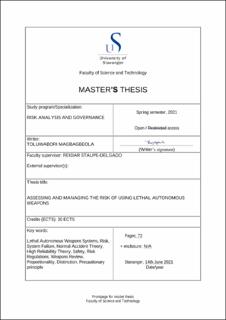ASSESSING AND MANAGING THE RISK OF LETHAL AUTONOMOUS WEAPONS SYSTEMS
Master thesis
Permanent lenke
https://hdl.handle.net/11250/2786353Utgivelsesdato
2021Metadata
Vis full innførselSamlinger
- Studentoppgaver (TN-ISØP) [1441]
Sammendrag
Over the last two (2) decades, there has been a surge in scholarly attention and a lot has beenwritten on the lethal autonomous weapons systems (also known as “Killer Robot”). The focus ofwriting has been on the legal, ethical, moral, and policy issues pertaining to Lethal AutonomousWeapons System (LAWS). Thus, a lot of attention and concerns have been directed to whathappens when a Lethal Autonomous Weapon System goes wrong? However, little or no attentionhas been directed to discussions such what are the risks surrounding the development, deployment,and use of Lethal Autonomous Weapons System LAWS? How should the international communityincluding countries address risk regulations of the Lethal Autonomous Weapon System if thereare uncertainties as to how these systems may fail?
This thesis addresses the risks attached to Lethal Autonomous Weapons System, complex, tightlycoupled and unpredictable high-risk technology. As such, the thesis debates the risks to LAWSfrom the Normal Accident Theory perspective and the discusses the uncertainty/unpredictabilityrevolving around LAWS. It goes further to argue whether the high-reliability theory can be usedas means of safety in Lethal Autonomous Weapon Systems.
In addition, this thesis addresses the obstacles of LAWS complying with risk regulations. Indiscussing that, it argues whether LAWS without human intervention can be said to appear to becapable of complying with the key principles of risk regulations such as the internationalhumanitarian law and the laws of armed conflicts principles of proportionality, distinction, andprecaution to bring about societal safety to the community where LAWS is deployed or engaged.This thesis is expected to direct attention and focus to discussions surrounding the risks ofdeveloping, engaging and deploying LAWS and the obstacles that LAWS presents in complyingwith risk regulations that can bring about safety in the use and deployment of LAWS.
Keywords: Lethal Autonomous Weapons Systems, Risk, System Failure, Normal AccidentTheory, High Reliability Theory, Safety, Risk Regulations, Weapons Review, Proportionality,Distinction, Precautionary principle
